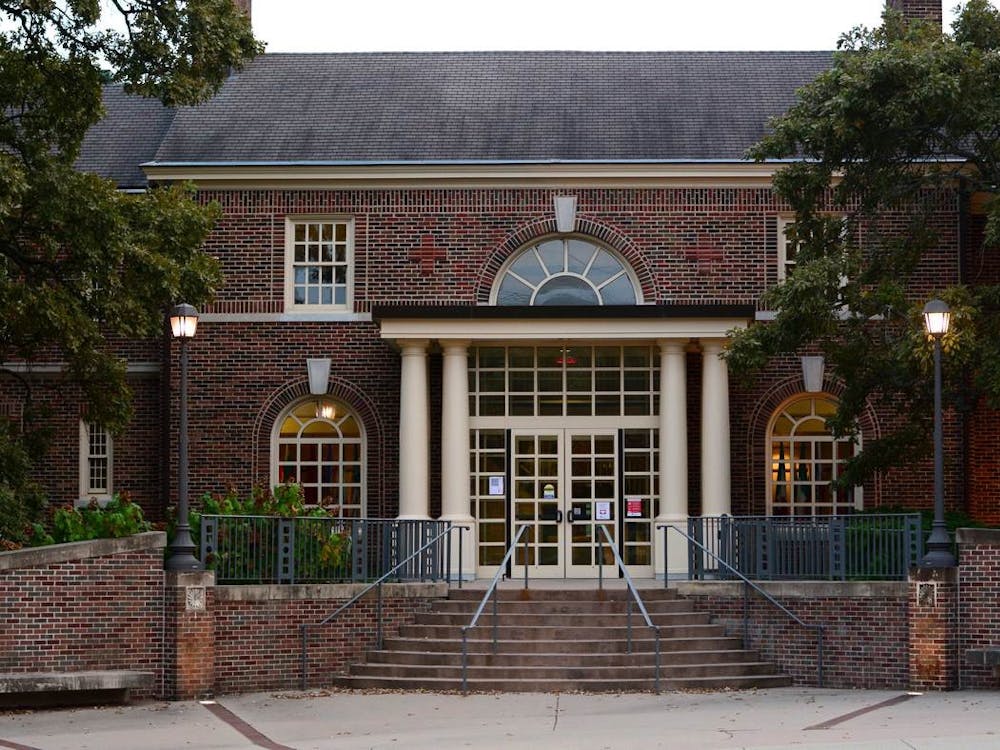
KATIE HINH PAGE DESIGNER
Four thousand dollars. For a college student, that can pay for a lot of textbooks, travel expenses or beer. But at Miami University, that's the amount of money - $3,896, to be exact - a student graduating in 2015 will have paid the Miami athletic department in four years of mandatory fees.
Most students are unaware an athletic fee exists. Of the students who know about the fee, most don't know what it supports. The university provides a simple itemization of how funds from the general student fee are spent, but it takes digging to find the information.
"I have no idea what it goes toward," senior Grant Beam said.
The RedHawks haven't given fans much reason to celebrate. In the past three seasons, the football team has collected four wins, and they've had two winning seasons in the last decade.
On average, Miami filled 65.5 percent of its stadium in home games last year, which ranks 31st out of 125 Football Bowl Subdivision schools for worst attendance percentage, according to an analysis by SB Nation. Attendance is not calculated by a head count of those present, so the stadium is often emptier than the percentage shows.
When the stadium is empty, students foot the bill.
During the past five years, public universities pumped more than $10.3 billion in mandatory student fees, direct institutional support and other subsidies into sports programs, according to an examination by The Huffington Post and The Chronicle of Higher Education.

The review included an inflation-adjusted analysis of financial reports provided to the NCAA by 201 Division I public universities. All reports were obtained through public records requests.
Subsidies increased 16 percent in that time, even as many schools cut back academic programs and laid off faculty in order to control costs. Student fees, which accounted for nearly half of all subsidies, increased by 10 percent.
That percentage is even higher at Miami. The athletic student fee increased 16.1 percent from $859 in 2010 to $997 in 2014. The fee made a minor drop to $977 in 2015, due to the larger enrollment. This year, athletic fees total $17.4 million.
Enjoy what you're reading?
Signup for our newsletter
College sports were never intended to be completely self-sufficient.
Only 21 big-name football schools bring in so much revenue that their athletics departments are completely self-sustaining. Those schools are members of the most powerful conferences - six from the Big 12, seven from Southeastern, six from the Big Ten and two from the Pacific-12.
Ohio State University, last season's national champions, totaled $145.2 million in athletic revenue in 2014. OSU needed $0 in subsidies, which translates to a $0 athletic fee for students.
Between Miami, Ohio University, University of Toledo and University of Cincinnati, the average net revenue before subsidies was a $19.6 million deficit in 2014.
Self-sufficient athletic programs are an exclusive group, and it's a far different story for those not in it. At 135 D-I programs, subsidies account for 50 percent of their athletic departments' income. So a student athletic fee is not new, nor is it unique to Miami.
The key question is: How much is too much?
"Not much more than what they're making us pay now," senior Drew Harmon said. "If it's around $1,000, that's probably a little higher than what I would be willing to pay if I had a choice."
Harmon and Beam, who have been attending Miami hockey, football, men's basketball and baseball games regularly since freshman year, agreed that "profit" from successful sports teams may manifest itself in an increase in attendance at games or positive PR for the school, rather than money.
The two seniors view Miami's overall subsidy as an investment, which makes the student fee more bearable for them.
"As athletics grow, your university grows," Harmon said. "I think that by putting money into athletics, it's an investment that might not immediately pay off, but it has the benefits of paying off in the future."
But those who aren't RedHawks sports enthusiasts like Harmon and Beam, aren't as understanding about the student fees.
"My first thought was the hockey team gets new uniforms every year, don't they?" junior Landon Drumm said. "I pay $1,000 for food. Food is necessary for life. What the hell is athletics ever doing for me?"
Miami's reliance on subsidies is alarming to some faculty members and raises questions about the long-term sustainability of college athletics.
"If the students decided to do a fee boycott, what would happen to the athletics program?" said Cathy Wagner, English professor and vice president of finance for Miami's chapter of American Association of University Professors. "I think, before tensions run too high, it would be important to be really clear about where their money is going."
Wagner suggested there's more to the problem: the university as a whole needs to rethink its priorities. She noted that new buildings and residence halls on campus, in addition to the football program, are "curb appeal" and may be absorbing funds that should be directed elsewhere.
"How much do people walk up onto the curb and into the building and start paying tuition on the basis of the curb appeal?" Wagner said. "It is a really tough thing to know, and I hope they're right, because they're going way into debt to do a lot of this stuff and exploiting the students for the student fees … [students] should be informed. If they're informed, then I wouldn't use the word exploited."
Although Wagner supports college athletics, she said she thinks the community should have a chance to discuss the fees.
"It does seem like if football is losing as much money as it seems to be, maybe that money could be redirected toward educational causes," she said. "I think a lot of faculty would agree with that."
Director of Athletics David Sayler said he has been working to reduce the reliance on student fees and bring in revenue from other places.
He highlighted three specific sources: television deals, ticket sales and donations.
Since Sayler's arrival to Miami in December 2012, the ESPN television deal with the Mid-American Conference has increased from $100,000 per school in the MAC to $1 million per school. And the ticket budget, mostly the result of hockey, has increased from $900,000 to $1.2 million in three years. The athletic department has raised more than $50 million in donations, which have funded 100 percent of the new athletic facilities.
Sayler pointed out how the size of the school affects the fee.
"We all get about the same amount of money from student fees," Sayler said. "Our challenge is our numbers are pretty much in line with all the other MAC schools, but we have lower enrollment. Kent State's got 42,000 students or something. Their ability to set a lower student fee is much greater than ours."
The student fee goes toward the general operating budget for athletics. Most of that budget funds scholarships for student-athletes, which, Sayler said, brings money back to the school.
For example, baseball players receive 25 percent of their tuition in scholarship money. When student-athletes attend Miami on partial scholarships, the rest of their tuition brings $8.6 million to the school.
Sayler said even though the new indoor sports facility is not funded with student fees, the department provides open hours for club and intramural athletes to use it. Miami also provides medical care for club and recreational teams through a new relationship with Mercy Health-Cincinnati.
"Those things combine, in my mind, to make the student fee justifiable," Sayler said. "Some people are never going to be happy that even any money is going to athletics, and I get that."
"Some kids are never going to use those things because they choose not to, but there's lots of things you pay to a university that not every student takes advantage of … it's just the nature of things."
Despite the disagreement on the level of the fee, there's one issue on which most around campus agree: transparency.
Sayler said Miami has looked into a website with an interactive breakdown of the student fees. University at Buffalo uses a similar model.
"The students need to know what's going on," Wagner said. "I think the administration needs to make a case for why it's appropriate for the students to be paying this amount of money."




